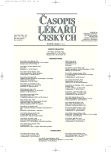Úvahy o poklesu prevalence infekce Helicobacter pylori a vředové choroby v posledních dvou dekádách
Authors:
Bohumil Fixa
Authors‘ workplace:
II. interní klinika LF UK a FN a Hepatogastroenterologie s. r. o., Hradec Králové
Published in:
Čas. Lék. čes. 2011; 150: 91-93
Category:
Review Article
Overview
A short overview is presented of some of the persistent questions of the relationship of Helicobacter pylori infection and peptic ulcer disease and about the increasing number of patients with idiopathic peptic ulcer disease. The relationship between the decrease of the prevalence of peptic ulcer disease in countries with marked decrease of Helicobacter pylori prevalence in the general population, including the Czech Republic, was discussed. Several possible causes of the decrease in Helicobacter pylori prevalence were noted (improving of socioeconomic conditions, such as low income and poor education, such as poor sanitation and overcrowding, bad hygienic conditions especially during childhood, the marked increase of Helicobacter pylori eradication rate, associated also with an extended therapy by macrolides or other antibiotics (amoxicillin, etc.) used for several conditions, often at a very young age, and sometimes by chance together with proton pump inhibitors, natural loss of the older generation, which had a higher HP-prevalence than the general population, the change of the stomach microbiome, etc.) but with the implication, that the real cause of these deep changes remains indistinctly identified.
Key words:
Helicobacter pylori, peptic ulcer disease, changes of prevalence.
Fi
Sources
1. Warren JR, Marshall B. Unidentified curved bacilli on gastric epithelium in active chronic gastritis. Lancet 1983; 321: 1273–1275.
2. Fixa B, Komárková O. Prevalence of Helicobacter pylori infection in various gastroduodenal disorders. Critical view on the basis of sufficient numbers of patients. A Czech experience. Čsl gastroenterologie a výživa 1993; 47: 57–58.
3. Fixa B, et al. Changing prevalence of some selected gastrointestinal diseases vis-ą-vis H. pylori infection. Hepato-gastroenterology (v tisku).
4. Gisbert JP, Calvet X. Helicobacter pylori – negative duodenal ulcer disease. Aliment Pharmacol Ther 2009; 8: 791–815.
5. Borody TJ, et al. Helicobacter pylori – negative duodenal ulcer. Am J Gastroenterol 1991; 86: 1154–1157.
6. Gisbert JP, et al. H. pylori – negative duodenal ulcer prevalence and causes in 774 patients. Dig Dis Sci 1999; 44: 2295–2302.
7. Ramirez Ramos A, et al. Changes in the prevalence of H. pylori in Peru; during the 1985–2002 period in medium and upper socio-economic strata. Rev Gastroenterol Peru 2003; 23: 92–98.
8. Chu KM, et al. Patients with Helicobacter pylori positive and negative duodenal ulcers have distinct clinical characteristics. World J Gastroenterol 2005; 11: 3518–3522.
9. Chiorean MV, et al. Changing rates of Helicobacter pylori testing and treatment in patients with peptic ulcer disease. Am J Gastroenterol 2002; 97: 3015–3022.
10. Arents NL, et al. Does the declining prevalence of Helicobacter pylori unmask patients with idiopathic peptic ulcer disease? Trends over an 8 year period. Eur J Gastroenterol Hepatol 2004; 16: 779–783.
11. Pietroiusti A, et al. Isolated H. pylori duodenal colonization and idiopathic duodenal ulcers. Am J Gastroenterol 2008; 103: 55–61.
12. Das JC, Paul N. Epidemiology and pathophysiology of Helicobacter pylori infection in children. Indian J Pediatr 2007; 74: 287–290.
13. Fixa B, et al. Výskyt infekce Helicobacter pylori v české dospělé populaci. Čes a Slov Gastroent 1995; 49: 83–85.
14. Dítě P, et al. Prevalence Helicobacter pylori v ČR – region jižní Morava. Vnitř Lék 1998; 44: 132–134.
15. Šterzl I, et al. Anti-Helicobacter pylori, anti-thyroid peroxidase, anti-thyroglobulin and anti-gastric parietal cells antibodies in Czech population. Physiol Res. 2008; 57 (Suppl 1): 135–141.
16. Fujisawa T, et al. Changes in seroepidemiological pattern of Helicobacter pylori and hepatitis A virus over the last 20 years in Japan. Am J Gastroenterol 1999; 94: 2094–2099.
17. Post PN, et al. Declining incidence of peptic ulcer but not of its complications: a nation-wide study in The Netherlands. Aliment Pharmacol Ther 2006; 23: 1587–1593.
18. Kang JY, et al. Recent trends in hospital admissions and mortality rates for peptic ulcer in Scotland 1982–2002. Aliment Pharmacol Ther 2006; 24: 65–79.
19. Bureš J, et al. Epidemiology of Helicobacter pylori infection in the Czech Republic. Helicobacter 2006; 11: 56–56
20. Bureš J, et al. Pokles prevalence infekce Helicobacter pylori v České republice. Čas Lék čes 2008; 147: 255–257.
21. Fiedorek SC, et al. Factors influencing the epidemiology of Helicobacter pylori infection in children. Pediatrics 1991; 88: 578–582.
22. Hestvik E, et al. Helicobacter pylori in apparently healthy children aged 0-12 years in urban Kampala, Uganda: a community-based cross sectional survey. BMC Gastroenterology 2010; 10:62doi:10.1186/1471-230X-10-62.
23. Hunt RH, et al. Helicobacter pylori in developing countries. WGO Practice Guideline 2006.
24. Konno M, et al. Five-year follow-up study of mother-to-child transmission of Helicobacter pylori infection detected by a random amplified polymorphic DNA fingerprinting method. J Clin Microbiol 2005; 43: 2246–2250.
25. Sasaki K, et al. Helicobacter pylori in the natural environment. Scand J Infect Dis 1999; 31: 275–279.
26. Polk DB, Peek RM. Helicobacter pylori: gastric cancer and beyond. Nature Reviews Cancer 2010; 10: 403–414.
Labels
Addictology Allergology and clinical immunology Angiology Audiology Clinical biochemistry Dermatology & STDs Paediatric gastroenterology Paediatric surgery Paediatric cardiology Paediatric neurology Paediatric ENT Paediatric psychiatry Paediatric rheumatology Diabetology Pharmacy Vascular surgery Pain management Dental HygienistArticle was published in
Journal of Czech Physicians

Most read in this issue
- Seemanová E, Hoch J, Seeman P. Heterozygous carriers of Slavic mutation 657del5 of NBN gene in patients with colorectal cancer
- Nagy I, Vinklerová V. The role of breastfeeding in the infant nourishment
- Ručka D, Lubanda JC, Karetová D, Skalická L, Vařejka P, Mrázek V, Linhart A. Carotid plaque exulcerated
- Marková I. Possibilities of health status examination in young men in the Czech Republic
